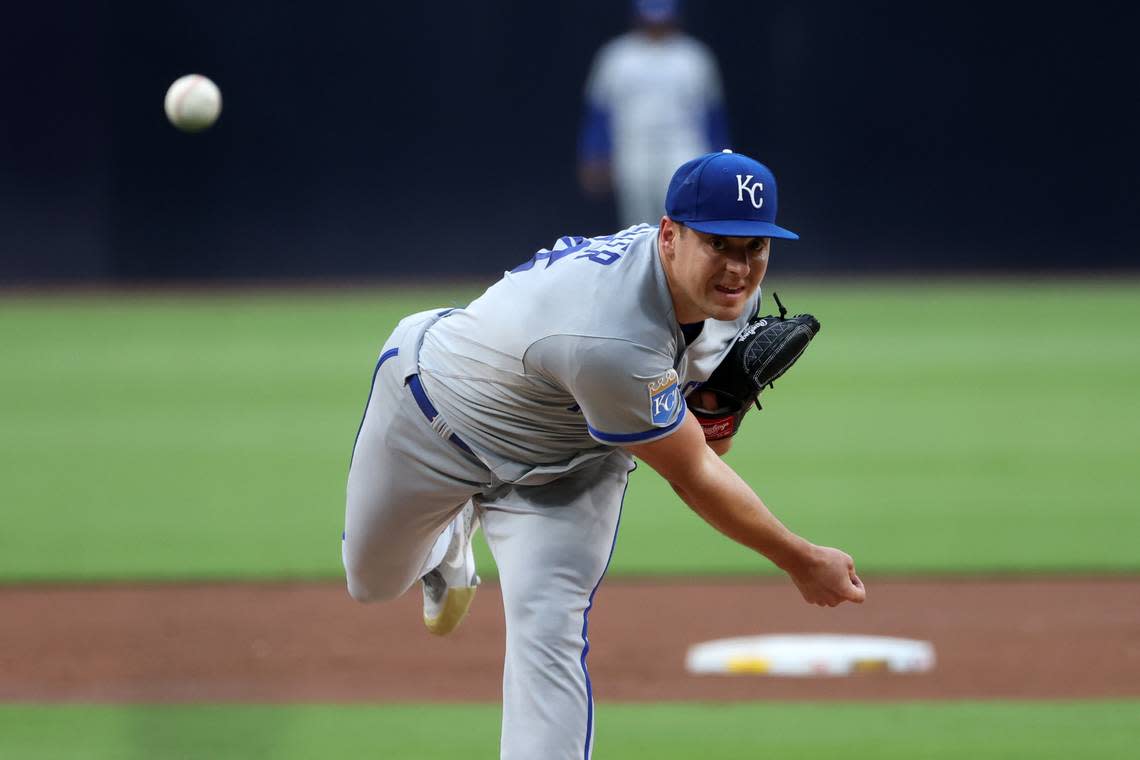Royals’ Brad Keller is walking batters at an abnormally high rate. So he’s changing this

Kansas City Royals pitcher Brad Keller understands the narrative regarding his professional career. Keller is lauded for having a strong pitch arsenal that features his fastball, curveball and changeup.
That pitching mix has allowed him to record a 4.25 ERA in six MLB seasons entering his Monday start in San Diego. But Keller has struggled with his pitch command.
Since his Royals debut in 2018, Keller has walked 50 or more batters in four of his six seasons. For his career, he’s averaged just shy of four walks per nine innings.
Through eight starts, Keller was on a similar trajectory. He led MLB with 32 walks in 39 2/3 innings.
He walked eight more batters in his ninth start of the year Monday, bringing this year’s rate to an astounding 8.3 walks per nine (40 walks, 43 1/3 innings).
“It’s kind of been my Achilles’ heel my whole career,” Keller said before the trip to San Diego. “It’s always been tempo, direction and walks. It’s something I’ve got to continue to work on every start.”
In recent starts, Keller began to tinker with his overall approach. He admitted that offseason work with Driveline Baseball — described by its website as a “data-driven baseball player development program” — altered his pitching mechanics. The Driveline tests revealed he was moving slowly with his pitching delivery.
As a result, Keller worked to speed up his tempo. It proved costly as he overcorrected and began flying open when throwing certain pitches. This contributed to elevated walk numbers as he searched for the best mesh point in his delivery.
“I feel like over my last couple of starts, I have gone almost too fast,” Keller said before Monday’s outing, in which he allowed two earned runs in 3 2/3 innings of work. “That is one thing we have worked on, trying to be fast but in a slower tempo.”
Prior to his start against the Chicago White Sox on May 10, Keller went back to the drawing board with the assistance of biomechanics technology. He looked at video footage regarding his overall delivery from start to finish on the mound.
He found that a relaxed approach could generate a better tempo.
“I’m trying to dial that back so that I can still stay in there a lot longer and deliver the pitch where I want it to go,” Keller said.
Keller turned in one of his best starts against the White Sox. He pitched five innings and allowed one run on three hits. He struck out four batters and issued four walks.
The improved start caught the attention of Royals manager Matt Quatraro. He noted that Keller looked more focused from the start.
“He really executed some pitches especially with his off-speed stuff,” Quatraro said after Keller’s start against the White Sox. “You saw the swing and miss he was getting with the off-speed which is big.”
Keller utilized his curveball more against the White Sox. He said a new grip contributed to better success within the game. He is now utilizing a higher grip on the baseball seams to generate more top spin against hitters.
His curveball has a 28.6 whiff percentage this season. Opponents were batting .167 on the pitch through his eight starts.
“My last ‘pen was really good with my curveball,” Keller said. “That’s probably the one I’m going to take into the game. When I get to throwing and warming up, I still will kind of mess around with it a little bit to get the consistent feel.”
Then came a tough test against the San Diego Padres on Monday night. The Padres feature a talented lineup consisting of MLB All-Stars Manny Machado, Fernando Tatis Jr. and Juan Soto.
Quatraro hoped Keller could throw first-pitch strikes to command the plate, believing that could be a key to success.
“The way I look at it is: What’s the alternative? Are you going to pick around the edges and try to miss? Then you are behind and really setting yourself up,” Quatraro said. “When you play against good hitters as a pitcher, you’ve got to attack. There has got to be an attack mindset and challenge for them to hit the ball.
“Brad has good stuff. We’ve seen it. He has a good fastball, good breaking ball and a good changeup. When he attacks and he stays in the zone, that is his best chance to put him on the defensive.”
Likewise, Keller was aware a strong effort against a talented Padres lineup could allow him to begin changing the narrative this season.
“I am just trying,” Keller said, “to put it all together.”
However, Keller failed to deliver against the Padres. The eight walks he issued were a career-worst mark. He couldn’t locate his fastball or off-speed pitches around the plate.
As a result, the Padres scored three runs while he was in the game. The Royals didn’t recover as they dropped the series opener at Petco Park 4-0.
“Not good. A lot of walks. Unacceptable,” Keller said after Monday’s start. “I put the team in a bad spot and put the bullpen in a bad spot. Just unacceptable.”
Keller also mentioned that he couldn’t find the mesh point in his delivery. He was operating either too fast or too slow as he navigated the lineup. It was something he and the team want to correct moving forward.
“I just need to continue to work on the right things and make the right moves towards the plate,” Keller said. “I just need to continue to have that in my mind and feel it over and over again.”


